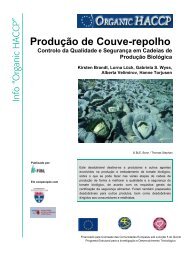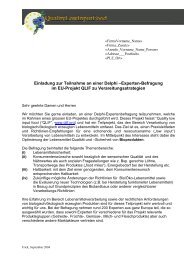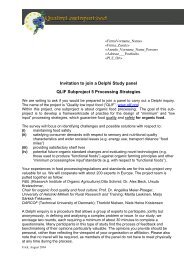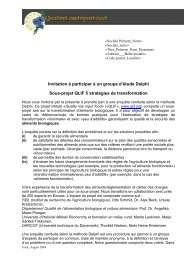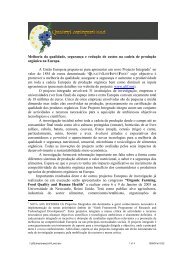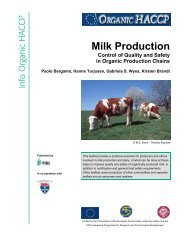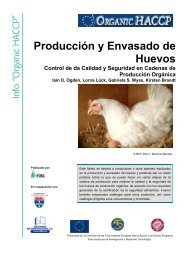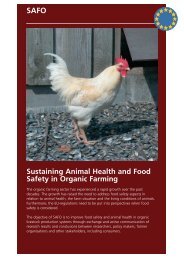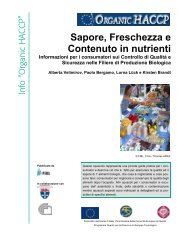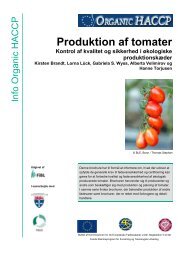Grape Production And Wine Processing
Grape Production And Wine Processing
Grape Production And Wine Processing
You also want an ePaper? Increase the reach of your titles
YUMPU automatically turns print PDFs into web optimized ePapers that Google loves.
The Organic HACCP Project leaflets<br />
This is no.14 of a series of 14 leaflets comprising information<br />
on how control of quality and safety can be further improved<br />
in organic supply chains across Europe. The Organic<br />
HACCP project has reviewed studies of consumer<br />
concerns and preferences in relation to organic production<br />
systems and collected information about typical production<br />
chains for 7 commodities in regions across Europe. For<br />
each of the criteria listed below, the information was analysed<br />
to identify Critical Control Points (CCPs), defined as<br />
the steps in supply chains where the qualities of the final<br />
product can be controlled most efficiently. CCPs were identified<br />
using methods developed for Hazard Analysis by Critical<br />
Control Points (HACCP), a standard procedure to prevent<br />
food safety risks. The new aspect is thus to improve<br />
how consumer concerns are addressed, through the use of<br />
the CCP concept for a wide range of criteria, not only safety.<br />
1. Microbial toxins and abiotic contaminants<br />
2. Potential pathogens<br />
3. Natural plant toxicants<br />
4. Freshness and taste<br />
5. Nutrient content and food additives<br />
6. Fraud<br />
7. Social and ethical aspects<br />
Overview of the chains examined for wine making<br />
Chain R2<br />
(Italy)<br />
<strong>Production</strong> of<br />
grapes by single<br />
producer<br />
<strong>Wine</strong> making by<br />
producer<br />
Transport of wine<br />
by transport<br />
Bottling by wine<br />
processor<br />
Transport of<br />
bottled wine by<br />
mail order<br />
Retail by mail<br />
order company<br />
Chain R3<br />
(Portugal)<br />
<strong>Production</strong> of<br />
grapes by single<br />
producer<br />
<strong>Wine</strong> making by<br />
producer<br />
Bottling by wine<br />
producer<br />
Transport of<br />
bottled wine by<br />
health food store<br />
Retail by health<br />
food store<br />
Chain R4<br />
(Switzerland)<br />
<strong>Production</strong> of<br />
grapes by single<br />
producer<br />
Transport of<br />
grapes by<br />
producer<br />
<strong>Wine</strong> making by<br />
wine processor<br />
Bottling by wine<br />
processor<br />
Transport of<br />
bottled wine by<br />
producer<br />
Retail by<br />
producer<br />
Chain R5<br />
(Switzerland)<br />
<strong>Production</strong> of<br />
grapes by single<br />
producer<br />
Transport of<br />
grapes by<br />
producer<br />
<strong>Wine</strong> making by<br />
wine processor<br />
Botteling by wine<br />
processor<br />
Transport of<br />
bottled wine by<br />
producer<br />
Retail by<br />
producer<br />
Chain R6<br />
(Switzerland)<br />
<strong>Production</strong> of<br />
grapes by single<br />
producer<br />
<strong>Wine</strong> making by<br />
producer<br />
Botteling by<br />
producer<br />
Retail by<br />
producer<br />
The diagram shows the analysed organic supply chains for<br />
wine throughout Europe. On the project’s homepage<br />
(www.organichaccp.org) they are shown in more detail and<br />
each of the CCPs are shown and described.<br />
<strong>Grape</strong> production<br />
Important issues to control at this step<br />
The typical wine taste is mainly determined by the cultivar.<br />
Secondary metabolites are the source of wine flavour, colour<br />
and taste. Their content is dependent on the cultivar, the<br />
microclimate and the nutrient supply of the grape vine.<br />
<strong>Grape</strong>vines have a low nitrogen requirement. Over-use of<br />
N-containing organic fertiliser can have negative influence<br />
on taste-relevant components in the wine.<br />
Specific problems for organic production<br />
Spray drift in regions with small-scale grape production by<br />
less careful conventional farmers or by helicopter applications<br />
(data from FiBL studies; see chart below) may result in<br />
contaminated grapes. It is the organic farmer who needs to<br />
take action to prevent any contamination of its products.<br />
Conventional<br />
Organic Rows<br />
Spray Drift [%]<br />
100<br />
by helicopter<br />
by regular spraying<br />
50<br />
25 25<br />
5 5<br />
1 1<br />
The fungal disease downy mildew, Plasmopora viticola, has<br />
traditionally been controlled by the use of copper salts, also<br />
in organic farming. The use of copper-based pesticides is a<br />
problem for the image of organic farming among consumers,<br />
and many retailers demand copper-free production. It<br />
has been banned from both conventional and organic farming<br />
in some Scandinavian countries and the Netherlands.<br />
Recommendations<br />
Select cultivars with good taste and low susceptibility to<br />
downy mildew and other diseases and pests. Make sure<br />
they have been tested and performed well in your region.<br />
Limit the use of N containing fertiliser and harvest late<br />
after sunny, warm days to optimise wine taste.<br />
If pesticides can have drifted onto your vineyard, get a<br />
leaf sample analyzed. If residues are found, either i) ask<br />
your conventional neighbour to buy the affected grapes<br />
from you for the same price as organic and cost of the<br />
analysis, or ii) harvest the first two rows separately, with<br />
subsequent separate processing and marketing.<br />
Agree with neighbours and helicopter operations on<br />
safety measures such as spraying only under certain wind<br />
conditions with well-maintained equipment, using substances<br />
allowed in organic farming on part of the conventional<br />
vineyard, restricting where the nozzles are open.<br />
Establish hedges or other barriers to protect the crop from<br />
spray drift from neighbours, and promote merging of small<br />
areas with organic vineyards including exchange of land.<br />
Use less than the permitted amount of copper (or none)<br />
and prepare for copper-free production in the future. Develop<br />
replacement strategies including the use of clay<br />
minerals, plant tonic and resistant cultivars.<br />
2




